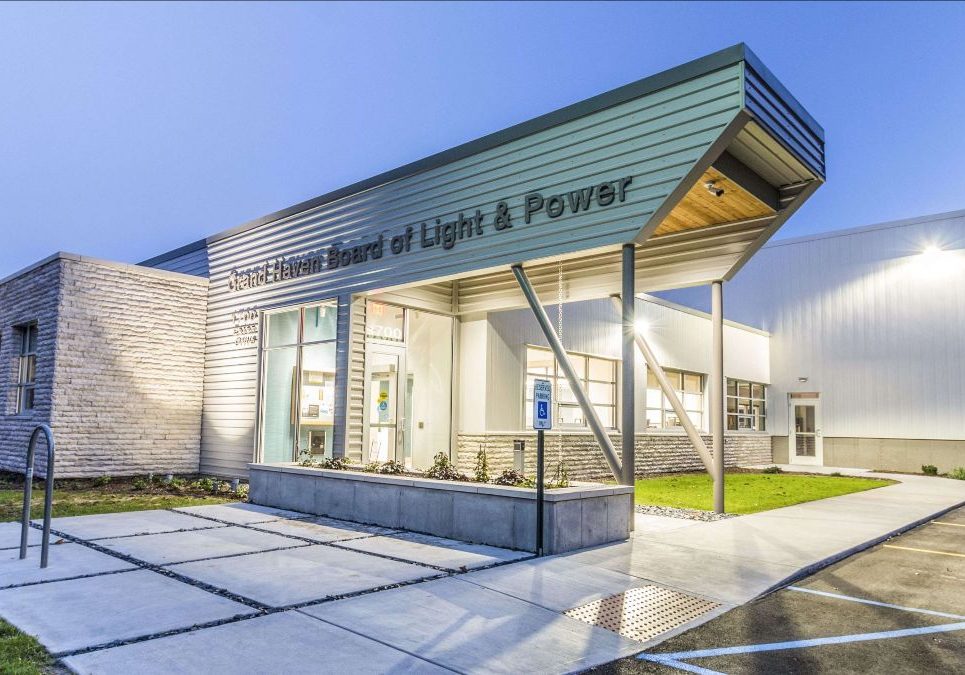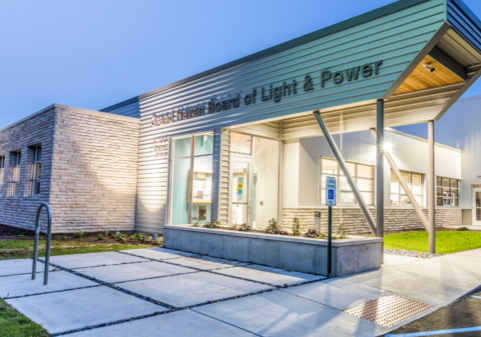March 3, 2021 – MLive “Public space, $17M power, heat facility planned for Grand Haven’s Harbor Island,” by Lynn Moore
A significant portion of Harbor Island in Grand Haven will be turned into a public recreation site with the removal of the J.B. Sims power plant while the rest is expected to house a $17 million heat and power facility.
That’s according to plans of the Grand Haven Board of Light and Power, which shuttered the plant in early 2020 and arranged for its demolition by explosives in February.
An estimated half of the property will be restored to wetlands and opened for community use. Plans call for potential expansion of the island’s Linear Park along the Grand River and designs show walkways and boardwalks throughout the area.
The rest of the site will be reserved for a new Operations and Technology Center that will include five gas-powered engines and five hot water boilers to provide backup electricity and heat for the city’s downtown snowmelt system. The site also holds a large substation that recently received $4 million in improvements and serves downtown and the western portion of the city.
Construction of the plant, which will take about two years, and environmental remediation will cost an estimated $25.6 million, according to information provided at a public presentation of plans last week. Demolition of the plant cost $5 million.
The Board of Light and Power intends to sell $45 million in bonds to pay for the center demolition, remediation and related costs, said David Walters, general manager of the Board of Light and Power. Bonds would be paid off in 20 years, he said.
The plan still needs formal approval by the board, and will need approval to sell the bonds from the Grand Haven City Council.
The proposed facility would be able to generate up to 12.5 megawatts of electricity, which is about 5 percent of the city’s energy needs, Walters said.
It typically would be used when costs of electricity the city buys from other producers is too expensive, providing a “financial backup” for the city and helping BLP control its costs, Walters told MLive.
“It’s able to come online when power costs are high,” he said.
When the generating engines are on, waste heat from them would be used for the snowmelt system that was built in 2010. However, those engines will not always be on, and that’s when the hot water boilers would be used for snowmelt, Walters said.
The Board of Light and Power is reimbursed by the city for the heat, which in turn collects some of those costs from downtown merchants. Excess heat from the Sims plant previously was used for the snowmelt.
The plant also will be able to provide backup electricity when solar and/or wind energy is not available, Walters said. The BLP buys about 8 percent of its energy from solar sources, 8 percent from wind energy and 8 percent from landfill gas, he said.
The plant also would provide some of the excess generating capacity that the BLP is required to have, which it currently must buy from other providers at a cost of about $4 million per year, Walters said. And it would be able to provide emergency power to the city on the rare occasion it would be necessary, he said.
The facility would be a precast concrete structure built on the power plant’s existing foundation, Walters said. It would have solar panels on the roof to provide energy for the facility.
Plans also call for a “solar garden,” comprised of solar panels that customers could buy and then have their electric bills credited for the energy they produce, Walters said. There also is space for future batteries capable of storing electricity.
Officials have said customer rates will remain unchanged.
The island site has housed a power plant since the 1960s and previously was viewed as a “waste land” that once held a garbage dump, said John Eberly of Progressive AE, the design firm working on the project. Cleanup of the site will involve removal of some old coal ash produced by the power plant and even trash from the old dump, Walters told MLive.
The city is in discussions with state officials over how much of the ash to remove and other parameters of the environmental remediation. The “ash and trash” is in an area BLP would keep for its use, Walters said.
Because the facility would be built on the existing foundation, environmental cleanup should not delay construction of the plant that could be operational by June 2023, Walters said.
Plans call for a prior coal yard area to be cleaned up, a berm in that area removed and that section on the south end of the property turned into turned into wetlands that would be open for public use, he said.
Plans show docks, boardwalks and trails in that area – but those would have to be created by “somebody else,” Walters said.
The city operates Linear Park on the southern edge of the island, but it has been severely damaged by high water.



